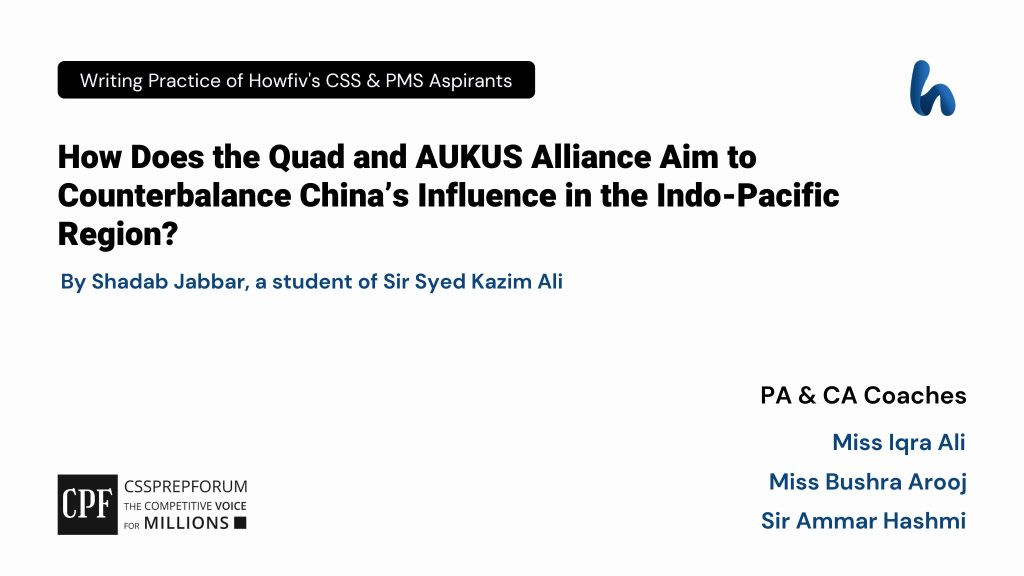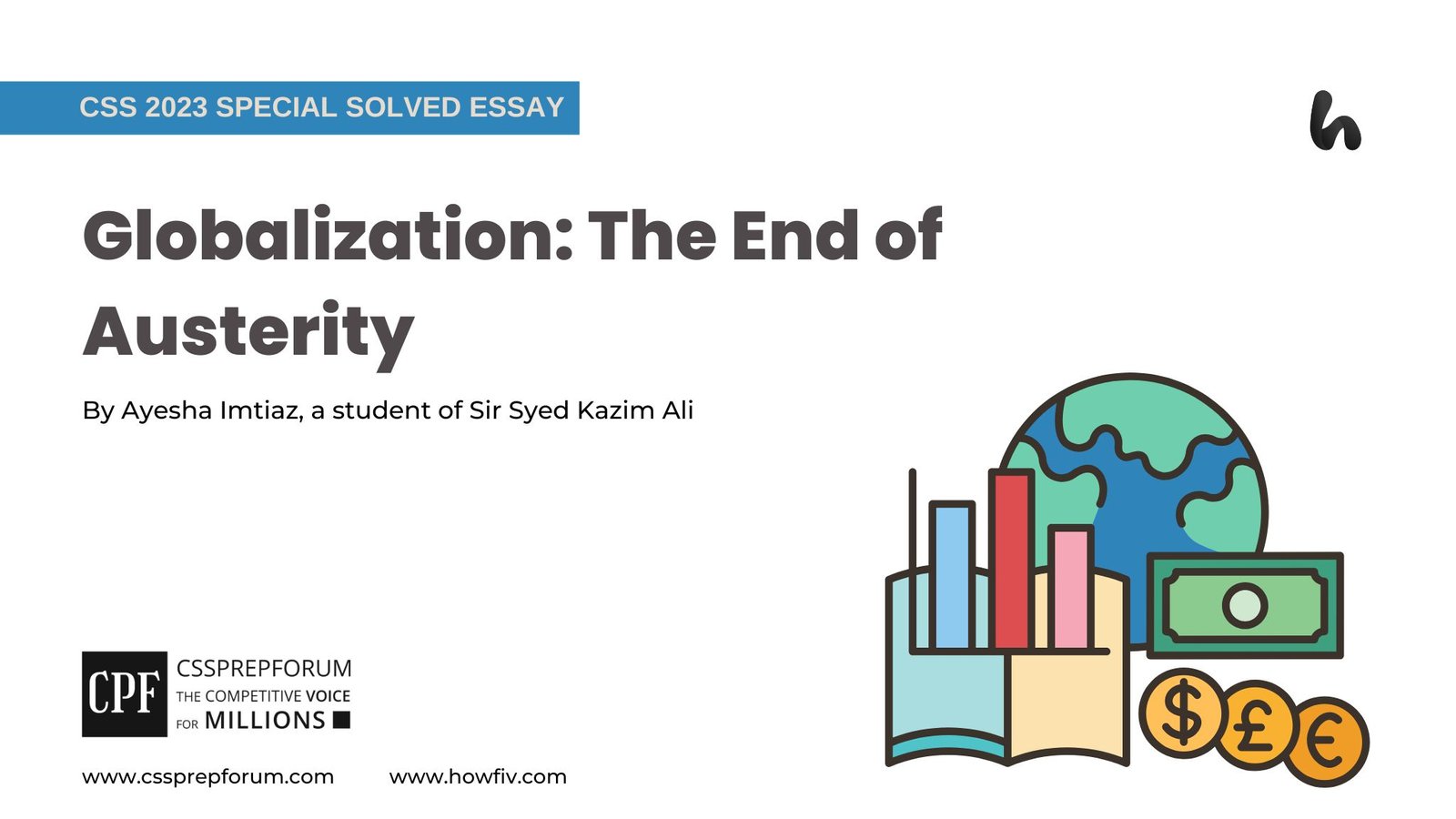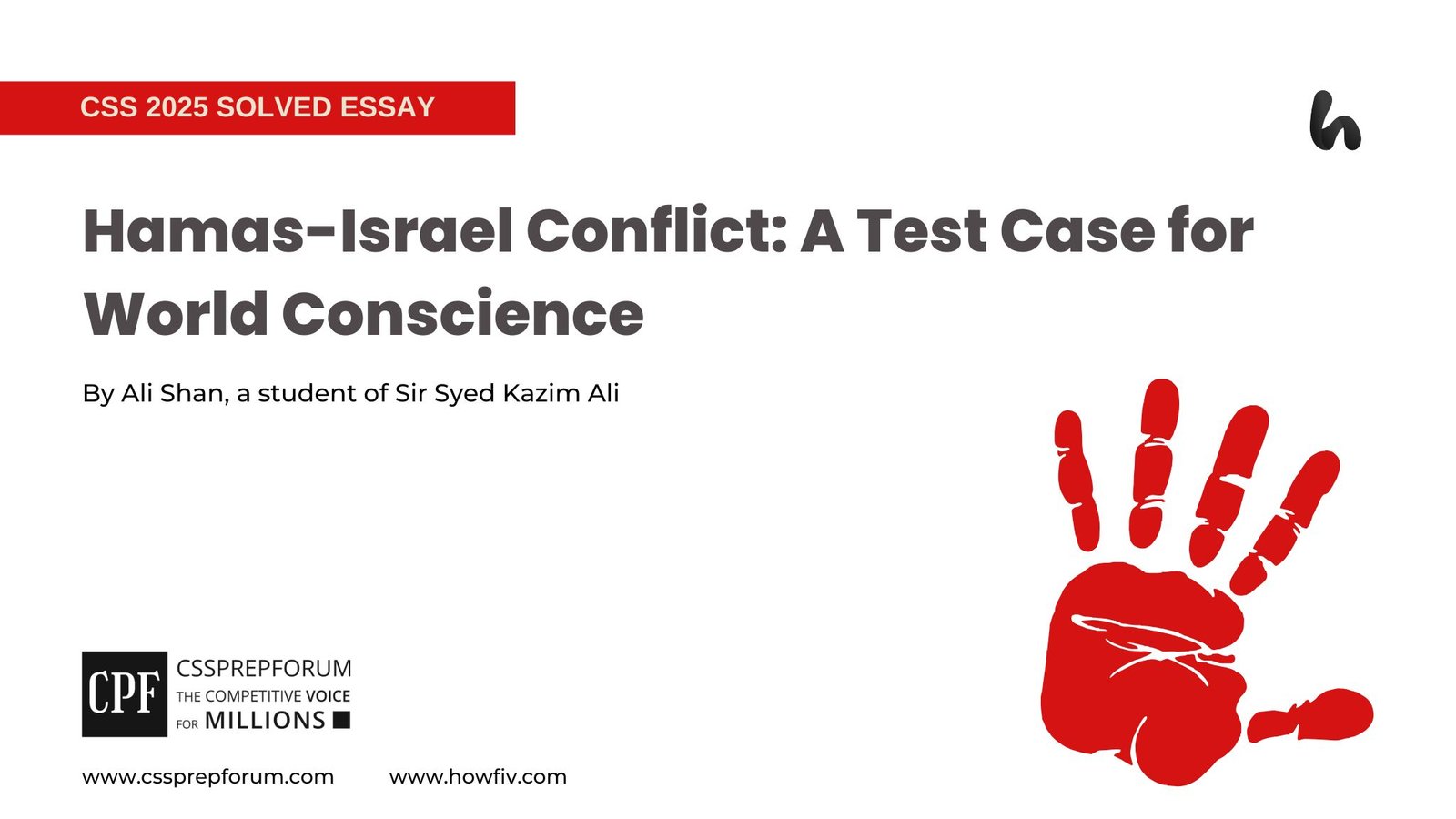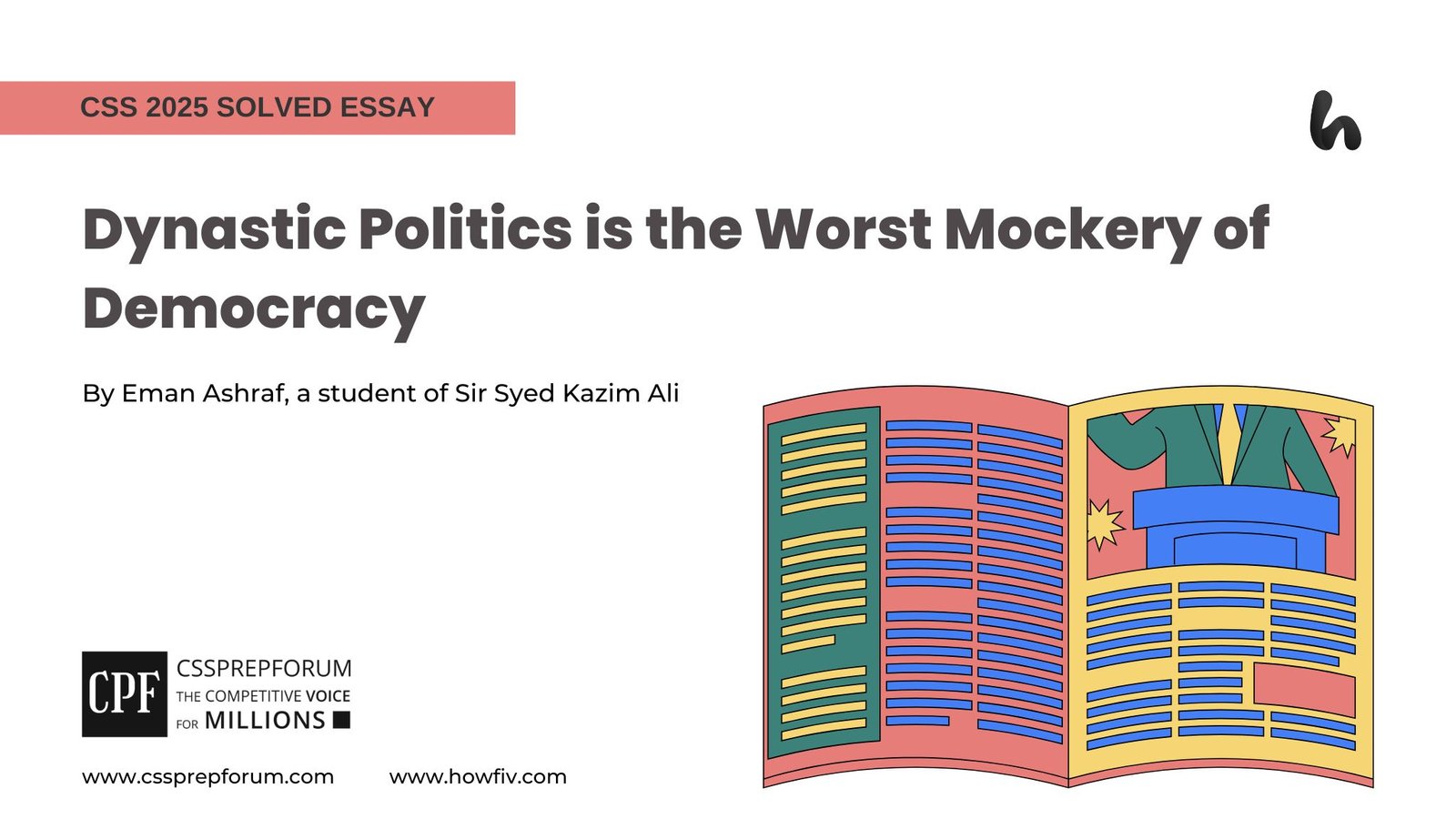CSS Current Affairs | Role of Quad and AUKUS to Counter China
The following question of CSS Current Affairs is solved by Shadab Jabbar under the supervision of Howfiv’s Pakistan Affairs and Current Affairs Coaches. She learnt how to attempt 20 marks question and essay writing from Sir Syed Kazim Ali, Pakistan’s best CSS and PMS English essay and precis teacher with the highest success rate of his students. This solved past paper question is attempted on the pattern taught by Sir to his students, scoring the highest marks in compulsory and optional subjects for years, and uploaded to help aspirants understand how to crack a topic or question, how to write relevantly, what coherence is, and how to include and connect ideas, opinions, and suggestions to score the maximum.

Outline
1- Introduction
2- Understanding the power tussle in the Indo-Pacific Region
3- An overview of the Quad and AUKUS
4- Efforts through which the Quad and AUKUS aim to counterbalance Beijing in the Indo-Pacific Region
- ✓Strengthening maritime security
- ✓Engaging in technological sharing
- ✓Committing to a “Free and open Indo-Pacific”
- ✓Opposing China’s “Debt trap” diplomacy
- ✓Initiating infrastructure partnerships
- ✓Cooperating on contemporary global issues
5- Conclusion

Answer to the Question
Introduction
The Indo-Pacific region, joining the Indian and Pacific oceans, is one of the most critical regions globally. For this reason, different countries have vested interests in the area, leading to a constant game of powerplay with far-reaching impacts. To begin with, China has been expanding its influence within the region through economic and military ventures and technological advancement. However, China’s assertive actions are perceived as a threat by the regional and relevant countries engaged in strategic partnerships like the Quadrilateral Security Dialogue and AUKUS. Consequently, the member states of the said pacts have been trying to counter the emergence of Beijing in the region. For instance, the Quad and AUKUS are involved in measures like strengthening maritime security, engaging in technological exchange, ensuring the region is free of any imposed coercion, opposing the debt trap tactics of Beijing, starting infrastructure partnerships, and making joint efforts to counter global challenges. Thus, by strengthening the Indo-Pacific region through such efforts, both forums aim to secure the region from the influence of the People’s Republic of China.
Understanding the power tussle in the Indo-Pacific Region
Ever since the disintegration of the USSR, the United States has led the current international order; however, China has recently benefited the most from it, particularly in economic terms. Over time, the hub of global trade and politics transformed from across the Atlantic to Asia-Pacific and now to Indo-Pacific with the inclusion of India to offset the increasing dominance of China in the region. Beijing has been accused of increasing its sphere of influence through military and economic coercion. In addition, the significance of the region lies in the fact that it serves as a juncture between the Indian Ocean and the Pacific Ocean, two of the most salient water bodies. Additionally, it makes up about 60 per cent of the global economy, homing seven of the top fifteen economies and over half the world’s population. Its importance can be weighted in the saying of Alfred Thayer Mahan, a great naval strategist, “Whoever rules the waves rules the world.” Furthermore, the People’s Republic of China (PRC) has been making its presence felt in the region, making the states opposed to its rise uneasy. This has become a driving force behind the tug of the power war among various stakeholders, including the United States, China, India, Australia, Japan, Southeast Asian countries, and others, in the region to secure their respective national interests. Hence, the Indo-Pacific region has become a host to the crosswalk of interest of multiple players in the transforming world order, resulting in impactful actions beyond the regional territory.
An overview of the Quad and AUKUS
The Quad stands for the “Quadrilateral Security Dialogue” (QSD); as suggested by the name, it comprises four member countries: The United States, India, Australia, and Japan. It is a loosely organized strategic forum initially set up after the Indian Ocean Tsunami of 2004 to assist with disaster relief and humanitarian aid. In 2007, the former Japanese Prime Minister, Shinzo Abe, formalised the security dialogue aiming to strengthen marine security at the “Confluence of the two seas” and promote collaboration between the four democratic countries in light of China’s expanding influence. However, notwithstanding the PRC’s scepticism regarding the forum and the divergent views of the member states, the Quad was disbanded in 2008. Nevertheless, the group was revived in 2017 after almost a decade of dormancy, given the rising concerns about the growing influence of Beijing in the region. The quadrilateral dialogue is an essential element that focuses on the Indo-Pacific region, especially in counterbalancing China’s assertive moves. As far as AUKUS is concerned, it is a trilateral security agreement between Australia, the United Kingdom, and the US unveiled on September 15, 2021. This strategic security pact’s design includes two pillars to strengthen the defense and deterrent capacities of its members as allies in the Indo-Pacific against the emerging PRC through providing nuclear submarine technology to Australia and other cooperative measures. Thus, both the Quad and AUKUS are pacts among states opposed to the rise of China and involved in cooperative measures, including military and economic, to neutralise Beijing in the region.
Efforts through which the Quad and AUKUS aim to counterbalance Beijing in the Indo-Pacific Region
- ✓Strengthening maritime security
The Quadrilateral Security Dialogue and the AUKUS alliance have maintained security cooperation in the Indo-Pacific region as one of their primary priorities in containing the PRC. For instance, all four countries of the Quad are engaged in exercises like Malabar (joint annual naval drills) since 2020. These exercises enhance interoperability and cooperation across the four navies, particularly about anti-submarine warfare. Similarly, AUKUS, although very young, poses as a tool for promoting military operational collaboration and synergy among its members. Adding to this, as reported by the Warsaw Institute, the Chinese media has referred to these ventures of maritime security collaboration as a “Pillar of the Asian NATO” that is backed by Washington. This highlights the potential of the increased military cooperation of the said alliances to discourage Beijing’s ambitions of becoming the hegemonic power by increasing the cost and hazards to the point where aggressive actions akin to that in the South China Sea become unfeasible.
- ✓Engaging in technological sharing
Technological sharing has taken centre stage in the Quad and AUKUS. In today’s era of globalization, technology holds the status of an imperative prerequisite for the development of all nations. This has led to sparking a technology-based cold war between Washington and Beijing. Hence, the first pillar of the trilateral security pact includes transferring nuclear propulsion technology from the United States to Australia. In contrast, the second pillar revolves around cooperating on advanced capabilities that will entail widespread technology and information sharing. Moreover, it seeks to advance research and collaboration in cutting-edge fields, such as electronic warfare, quantum computing, robotics, Artificial intelligence (AI), enhanced cyber capabilities, and hypersonic and autonomous submarines. Furthermore, as stated in research published by the Observer Research Foundation, “The Quad launched its Critical and Emerging Technology Working Group in March 2021.” Through this body, all four member states have been putting forth strategies to use technology to advance society, the economy, and the military might in the regional vicinity. Thus, the US’s sharing of nuclear-powered Submarines with Australia implies that China is up against a formidable new defensive alliance in the Indo-Pacific region. Adding to this, the alliances-led technological cooperation opposes Beijing’s rise as a technological power and its disruptive actions in the region regarding its nefarious application of AI for surveillance, propaganda, and censorship.
- ✓Committing to a “Free and open Indo-Pacific”
The Quad and AUKUS have pledged unwavering commitment to a “Free and open Indo-Pacific.” The PRC has been increasing its influence in the Indo-Pacific since about 60 per cent of its trade occurs through the marine routes. Beijing is doing so mainly by investing in countries through the Belt and Road Initiative (BRI), increasing its regional military presence, and being a significant trading partner to many South Asian nations. For this reason, the alliances are focused on preventing China from having any influence over the vital sea routes in the region. The US Secretary of State- Antony Blinken- during his 2021 speech at the University of Indonesia, commented that ensuring the world’s most dynamic region remains uncoerced and open to everyone is a shared interest of all the allies. The statement was once again backed by the statement of the leaders of the QDS during its 2023 third summit in which they reaffirmed their relentless dedication to the cause, ensuring the freedom of navigation, compliance with international law, peace and stability in the region. Thus, the alliances aim to counterbalance China by ensuring that the Indo-Pacific region’s countries have the liberty to operate without being subjected to any external pressure.
- ✓Opposing China’s “Debt trap” diplomacy
The foreign ministers of the Quad and AUKUS member states have raised concerns regarding sustainability in funding infrastructure projects and getting trapped in a vicious cycle of debt in the Indo-Pacific region, particularly about the BRI. Additionally, Sri Lanka has been portrayed as the face of the Beijing-caused debt trap ever since the port of Hambantota was turned over to China in 2017. Besides Sri Lanka, other Indo-Pacific nations, like Pakistan and Laos, are heavily indebted to the PRC and are facing severe economic crises. According to the Economist, “53 economies are at risk of experiencing a debt crisis; more than a third of most indebted countries globally owe the highest debt to Chinese lenders.” Hence, ministers from Canberra, Tokyo, New Delhi, and Washington, during the QDS` 2022 fourth Foreign Ministers meeting in Melbourne, emphasised the need for offering alternate funding and assistance sources to these countries and collectively pledged to “Oppose economic policies that are coercive and undermine the current world order.” In this context, the Quad nations have provided training programmes across the Indo-Pacific region to help improve their capacity to manage debt so they can be saved from falling victim to Chinese debt, resulting in its expanded sphere of influence.
- ✓Initiating infrastructure partnerships
The countries of the pacts, particularly the Quadrilateral Security Dialogue, collaborate in infrastructural development to counter China’s Belt and Road Initiative. The initiative encompasses over 150 nations and is worth about 92.4 billion USD. Moreover, according to the US Department of State, “In 2019, the United States, Japan, and Australia formed the ‘Blue Dot Network’ to evaluate and accredit infrastructure development projects across the globe.” Following this, the leaders of the Quad disclosed new infrastructure partnerships in 2021 and the ‘Quad Infrastructure Fellowship Program’ in 2023. Furthermore, all these efforts are aimed at strengthening the Indo-Pacific regional nations by equipping them with sustainable infrastructure development. Other than this, the member states seek to promote their regional soft power by utilizing their respective competitive advantages and undermining Beijing’s BRI.
- ✓Cooperating on contemporary global issues
The partnerships have the potential to tackle emerging issues of the modern era through joint efforts. These issues include cyber security, pandemics, climate change, and consequent natural disasters. The Quad’s origin is providing essential public goods to the region, such as disaster relief and humanitarian assistance, after the 2004 Indian Ocean Tsunami. In addition, the countries’ leaders have recognised the importance of tackling global issues as one of the ways to counter the PRC’s expanding influence and to nullify its blame for establishing an “Asian NATO” by identifying the challenges said in the 2021 summit. A glaring example of these efforts is the establishment of ‘The Quad Climate Change Adaptation and Mitigation Package’ (QCHAMP) in 2022. Thus, the QDS can neutralise Beijing in the Indo-Pacific region by fostering realistic collaboration to address global issues and empowering the region to combat these issues with resilience.
Conclusion
The Indo-Pacific region holds great importance, especially its geostrategic location. With the transitioning global order, the region has fallen victim to intense competition among prominent international actors. For instance, the People’s Republic of China has embarked on a journey of growing its influence in the region by strengthening its economic, military, and technological might. However, the emergence of Beijing has become a source of discomfort among the stakeholders and beneficiaries of the existing international order. As a result, strategic partnerships like the Quad and AUKUS have come into being to counterbalance China in the said region. Elaborating further, these diplomatic pacts aim to do so by making efforts, including strengthening maritime security, sharing technology, ensuring a ‘Free and open Indo-Pacific’, countering Beijing’s debt traps, developing infrastructure, and addressing global issues. Hence, the United States, the United Kingdom, Australia, Japan, and India- through the QDS and AUKUS- are taking measures to collaborate in all possible sectors to counter the PRC in the Indo-Pacific region.

CSS Solved Past Papers’ Essays
Looking for the last ten years of CSS and PMS Solved Essays and want to know how Sir Kazim’s students write and score the highest marks in the essays’ papers? Then, click on the CSS Solved Essays to start reading them.
CSS Solved Essays
CSS Solved Islamiyat Past Papers
Want to read the last ten years’ Islamiyat Solved Past Papers to learn how to attempt them and to score high? Let’s click on the link below to read them all freely. All past papers have been solved by Pakistan’s top CSS Islamiyat coach having the highest score of their students.
CSS Solved Islamiyat
CSS Solved General Science & Ability Past Papers
Want to read the last ten years’ General Science & Ability Solved Past Papers to learn how to attempt them and to score high? Let’s click on the link below to read them all freely. All past papers have been solved by Pakistan’s top CSS GSA coach having the highest score of their students.
CSS Solved General Science & Ability











